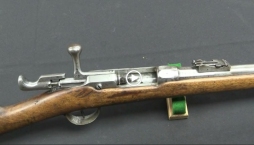The Chassepot was the French answer to the Dreyse needle rifle, and also the only other needlefire rifle to see major military service. It was adopted in 1866 and served as a primary French infantry rifle until being replaced by the 1874 Gras rifle, which was basically a conversion of the Chassepot to use self-contained brass cartridges. The concept of a need rifle is that of a breech loading rifle using paper cartridges. A primer was set in the base of the cartridge (inside the paper), and upon firing the needle-like firing pin would pierce the paper cartridge and detonate the primer and powder charge. The system always had trouble with sealing the breech, but was still a significant improvement over muzzleloading rifles. This example at RIA is heavily used, but appears to be complete and fully functional.
Share this link
 

I have wanted one of these for a while, know where I can find a good one, and can not justify spending the money right now. Ian, you are not helping!
All joking aside, thank you for doing this and the Dreyse video. More european black powder rifles please. A Kropatschek would be awesome.
Think of all the steels, carbides, and Titanium pins that one can easily buy today from a machine shop tool supplier.
I believe a needle rifle could be made as reliable as an old Mauser.
I have one of these and shoot it regularly.. it is remarkably reliable and, for it’s time, pretty accurate. I have shot it at 900yds and hit the target most of the time!
The ammunition is not that difficult to make ‚Äď I use gummed brown paper, top hat percussion caps and Lee .45 cast lead bullets. The obturators can be made from European tap (faucet) washers and the needles from Tig welding rod. Using modern butyl rubber and stainless steel needles cures many of the original problems..
Iain‚Äôs description of the bolt head is a little confusing! The purpose of the ‚Äúprobe‚ÄĚ thing on the end of the bolt is not to penetrate the cartridge. The cartridge is designed to sit on the tip of the bolt extension which creates a void behind the cartridge in the chamber. When the round fires, this space fills with high pressure gas which is then used to blow the cartridge debris, including the percussion cap, out of the bore behind the bullet. The paper cartridge is not consumed in the chamber! This works surprisingly well ‚Äď you do get fouling building up at the front of the chamber, which needs brushing out occasionally but I never found caps or debris in the bore.
‚ÄúThe system always had trouble with sealing the breech, but was still a significant improvement over muzzleloading rifles.‚ÄĚ
Russian Army briefly used Karle rifle (–≤–ł–Ĺ—ā–ĺ–≤–ļ–į –ö–į—Ä–Ľ–Ķ) converted from muzzle-loader, however it was soon found to be too expensive and replaced by Krnka Model 1867 converted from muzzleloader rifle firing metallic cartridge (known outside Russia as ‚ÄúRussian Krnka rifle‚ÄĚ)
https://ru.wikipedia.org/wiki/%D0%98%D0%B3%D0%BE%D0%BB%D1%8C%D1%87%D0%B0%D1%82%D0%BE%D0%B5_%D1%80%D1%83%D0%B6%D1%8C%D1%91#.D0.92.D0.B8.D0.BD.D1.82.D0.BE.D0.B2.D0.BA.D0.B0_.D0.9A.D0.B0.D1.80.D0.BB.D0.B5
The only thing keeping the bolt in the gun is one bolt?
Obviously, the rifle worked, as the French used them for years, but that would worry me a touch.
This is quite a common feature of several cheap, bolt-action shotguns and the like from the pre and post-WWII era. I have a very fine JC Higgins 20 gauge bolt action shotgun (1946 produciton, in excellent/like-new shape, paid $60 for it) which has a screw which holds in the bolt. They do have a reputation for being ‚Äúdangerous‚ÄĚ for this reason, and a recall was issued (where the screws were loctited in place), but I simply ensure that screw is tight whenever I use it, and it has been safe and reliable.
The screw prevents the bolt from being pulled out the back of the receiver. When you close the bolt, it has a big locking lug that engages, which is what holds against the pressure of firing.
Ahhh, I see the light.
the principal problem is the risk of eyes injuries is you forgot the rubber seal of the bolt….
in france they are not rare (but relatively expensive now) but i would prefer shoot a replica for preservation of originals.
maybe one day a modern replica (ardesa / artax / pedersoli)